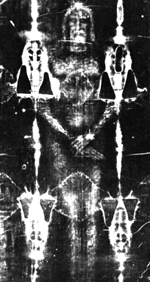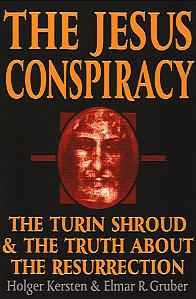|
The Shroud of Turin The Shroud of Turin: Dirty rag, work of art, or miraculous relic?
The Shroud of Turin: Dirty rag, work of art, or miraculous relic? If you're looking for an answer anytime soon, we strongly suggest you stop holding your breath immediately. It's not surprising that a direct relic of Jesus Christ would be a controversial object. In fact, it would be surprising if it wasn't. What is somewhat unexpected, however, is the nature of the controversy. You would think an inexplicable image of the crucified Christ would be welcomed by Christians everywhere as a proof of the Bible's veracity. However, you would be quite wrong. The history of the Shroud is layered with allegations of fraud, deception and heresy. Which is why it's so much fun, really. The earliest verifiable reports of the Shroud's existence date back the 13th century, although it obviously would be older than that if it was in fact wrapped around Jesus' moldering corpse (or not, as we shall see). The Shroud was a big hit with the medieval relic-mongering public, but the Catholic church quickly moved to suppress the cloth, which seems to bear a faint image of the body of Christ, just barely visible to the naked eye. A fire in the 15th century seared the impression of the Shroud's display case onto the cloth, but didn't damage the image.
For the next couple hundred years, the Shroud made the rounds of Europe in public and private showings. Church authorities vacillated between locking it away and allowing the unwashed masses to gawk at their Savior's deathbed picture. It wasn't until the 20th century that the whole affair rose above the level of routine relic veneration and became a scientific mystery. As the 19th century became the 20th century, the new art of photography was used to record the image on the Shroud. When the photographer developed his film, he made a startling discovery. What in real life appeared as a barely distinguishable stain on the cloth became incredibly vivid when viewed as a negative. The find sparked a new resurgence in interest in the Shroud, both among the devout and among scientists, who eagerly raced to disprove the cloth's authenticity.
A back-and-forth volley of shots over the cloth's scientific merit ensued, which was seemingly resolved in 1989, when radiocarbon dating of a small sample provided by the Vatican conclusively proved the artifact dated back only to the medieval period. But this was not the end of the story. The circumstance of the testing came under fire almost immediately. The Vatican had placed a cardinal in charge of the security of the samples, and there was ample room to maneuver if a switcheroo was desired. But why? Surely the burial cloth of Christ was a coup for the Church? Maybe not. A number of fairly exotic Conspiracy theories arose around the cloth, with most of them centered on various reasonably far-fetched plots of ancient origin, involving everything from the Masons to the "face on Mars."
Like several other shroud theorists, the authors were able to create a passable recreation of the image. They also did some groundbreaking work in tracing the Shroud's possible movements prior to the 14th century, which had the cloth moving from the Essenes to the gnostic heretic sect of the Cathars, from thence to the Knights Templar, before finally falling into the hands of the Church. Since the Church has a vested interest in promulgating the whole "died on the cross and rose again in three days" story, the authors argued, the Vatican substituted a cloth sample stolen from a known medieval artifact and submitted it for testing. The whole story is surprisingly credible, although it still requires human beings (known to be generally incompetent) to have pulled off a successful conspiracy to hide the biggest secret of all civilization for thousands of years. Coulda happened. But did it? The Church has formally and emphatically canceled all further research on the Shroud once they got the "harmless" radiocarbon date, so your best bet at finding out the truth would be to die and ask whomever you happen to meet in the world beyond. Even this isn't a sure thing, since you might find yourself non-existent, reincarnated or sentenced to Hell, which is reportedly not big on satisfying the curiosity of its residents.
Editor's note: |
 The cloth was caught in a three-way tug of war between its alleged owner, the family of a French knight, the religious authorities and the French monarchy. This went on for decades in a series of machinations that involved the use of force, large sums of money changing hands, and even the excommunication of the Shroud's more or less rightful owners. It wasn't until nearly the 16th century that the artifact eventually ended up in the Italian town of Turin, from whence its modern name originates.
The cloth was caught in a three-way tug of war between its alleged owner, the family of a French knight, the religious authorities and the French monarchy. This went on for decades in a series of machinations that involved the use of force, large sums of money changing hands, and even the excommunication of the Shroud's more or less rightful owners. It wasn't until nearly the 16th century that the artifact eventually ended up in the Italian town of Turin, from whence its modern name originates.  It took a while. Modern science yielded a series of contradictory bits of evidence about the cloth, examining its weave and microscopic particles caught in the fibers. Computer analysis of the image revealed 3-D contours inconsistent with the theory that a medieval artist has simply painted the picture.
It took a while. Modern science yielded a series of contradictory bits of evidence about the cloth, examining its weave and microscopic particles caught in the fibers. Computer analysis of the image revealed 3-D contours inconsistent with the theory that a medieval artist has simply painted the picture.  One of the most credible attempts to address the outstanding issues appeared in a book called "The Jesus Conspiracy," teamed an investigative reporter and a historian to weave a fabulous tapestry of the be-all, end-all mother of all conspiracies. According to the authors, Christ had been rescued still alive from the cross by members of a contemporary sect of healers known as the Essenes, who treated him with medicines like aloe and myrrh, which they soaked in a cloth and wrapped around his body. You see where this is going.
One of the most credible attempts to address the outstanding issues appeared in a book called "The Jesus Conspiracy," teamed an investigative reporter and a historian to weave a fabulous tapestry of the be-all, end-all mother of all conspiracies. According to the authors, Christ had been rescued still alive from the cross by members of a contemporary sect of healers known as the Essenes, who treated him with medicines like aloe and myrrh, which they soaked in a cloth and wrapped around his body. You see where this is going.